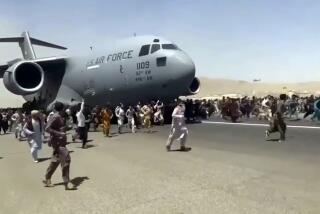Afghanistan as History
- Share via
In these days of high-rolling international arms deals, photographs of tanks kicking up dust--their crews sitting by open hatches, helmets slightly askew--are fairly common. But what we saw over the weekend were Soviet tanks arriving in Kabul, Afghanistan, to refuel and then head north on the second leg of a withdrawal that eventually will see 115,000 Soviet troops leave the country that they occupied in 1979. What made the scene both startling and historic is that only yesterday there were so many reasons for its never happening.
For most of the 70 years since the revolution, Soviet pride, for example, made it unthinkable for its leaders to admit a mistake. It was to have taken hold at the last minute and blocked any retreat. Yet there was a Soviet officer on Sunday, feeling free to tell Times correspondent Michael Parks in Kabul that it had all been a mistake, that he was not sure that the Soviets had helped their neighboring socialist government or even that the government had wanted help.
The so-called Brezhnev doctrine was supposed to make it unthinkable that the Soviet Union would turn its back on a fellow socialist state when there was a chance that it might fall. If that did not block a withdrawal, there was the ancient tradition, started in the days of the czars, of keeping tight control over nations on their borders.
Despite these supposedly solid reasons, the tanks kept rolling. So much for the old reasons that the Soviets would never leave Afghanistan. Now Washington must set those aside and try to pin down the reasons why they did leave. Until it can put the new reasons together, Washington is going to be hard pressed to fashion a realistic policy for dealing with Moscow in a world that obviously is changing faster than seemed possible not long ago.
One possible explanation is the shoulder-fired Stinger missiles that America smuggled to Afghanistan guerrillas, who have used them to shoot down somewhere between 150 and 200 Soviet aircraft since 1987.
It may well have been a combination of the Stingers and other trends; as the Soviet captain told Parks, the terror and bloodshed that Soviet troops were sent to suppress had increased, not decreased, since 1979.
What Mikhail S. Gorbachev has called the “turmoil” in his country that surrounds his effort to breathe life into a dying economy obviously has something to do with his abrupt decision to leave without knowing whether or not the Communist government in Kabul can survive. That turmoil may also lead to similar Soviet decisions to disengage from other losing battles abroad to concentrate on making the system work better at home.
Some of the new reasons sound sensible, but so did some of the old reasons. A certain amount of time will have to pass before analysts will risk saying which are basic and which are transient. But it is in America’s interest not to take too much time in figuring it out.
More to Read
Sign up for Essential California
The most important California stories and recommendations in your inbox every morning.
You may occasionally receive promotional content from the Los Angeles Times.













